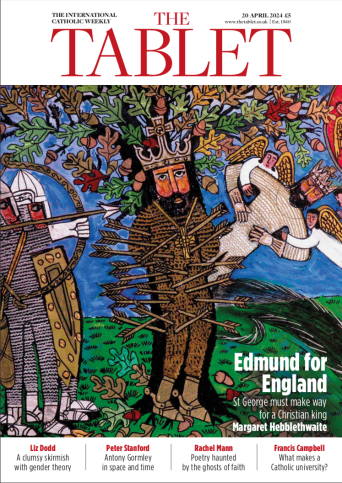Chemin Neuf is a French Catholic movement with an ecumenical vocation that has grown rapidly since it was founded 40 years ago. Next month, four members will move into the Lambeth headquarters of the Archbishop of Canterbury and tomorrow they start running a large Catholic parish
Establishing its first base in Britain less than 15 years ago, the religious movement Chemin Neuf has risen remarkably.
In January 2014, members of the French Catholic community are moving into Lambeth Palace, the Archbishop of Canterbury’s London home and headquarters, while tomorrow (8 December) they will formally take over the running of a prominent Catholic parish in north London: Christ the King in Cockfosters.
This is not bad going for one of Britain’s smaller religious movements with, according to its latest accounts, an income of just £183,982. To put this into context, the British Jesuits’ income for last year was £37.8 million.
The group, whose name translates into English as “new way”, is Catholic but with an ecumenical vocation. It was founded 40 years ago in Lyons by a group of seven people who had encountered the charismatic renewal.
One of them was Fr Laurent Fabre, then a Jesuit priest, and another, Jacqueline Coutellier, was in formation to be a Carmelite nun. Soon afterwards the original group was joined by several couples and the movement now consists of a number of communities where celibate men and women live alongside married couples.
The Jesuit and contemplative influences remain a big part of the order’s spirituality. Chemin Neuf houses say the daily offices, daily Mass and have Eucharistic Adoration. But they also have an emphasis on the less structured charismatic prayer – hands in the air, eyes closed with some praying in tongues.
It is a spiritual mix that seems to be popular. Although it started in France, Chemin Neuf has spread to more than two dozen countries including Canada, Brazil and Egypt. The community, which includes those from across the Christian denominations, is recognised by the Catholic Church as a public association of the faithful while its institute that forms men to be priests is a clerical institute of pontifical right.
Today, there are around 300 consecrated brothers and sisters. They do not wear habits, nor is there a uniform for the community, although members tend to wear white, beige or brown clothes along with a small wooden cross, made in the Ivory Coast.
One of the most popular parts of the group’s outreach is its work with married couples known as Cana sessions. These are six-day residential retreats where couples deepen their faith and relationship with one another. In France they attract up to 200 couples at a time. Children are looked after during the retreat so couples are able spend time together, in prayer and hearing talks.
It was a Cana session in 1993 led by an Anglican priest, Charles Hadley, that was Chemin Neuf’s first foray into Britain. He had encountered the group in France and was attracted by its “loyalty to tradition combined with a boldness to entrust everything to God”. Six years later the group established its first permanent residence in St Gildas Christian Centre, Langport, in Somerset, which had once housed the Sisters of Christian Instruction (the nuns still own the property).
Another part of the group’s work is reconciliation, which takes shape in the Siloam programme. Siloam retreats take place in three four-day sessions over a year and help bring about inner healing and reconciliation; they bring in doctors, psychiatrists and therapists and, according to a Chemin Neuf booklet, “strive to consider people in all their being (physical, psychological and spiritual) so that their health may be ordered to salvation in Jesus Christ”. Hadley explained that the idea is to allow the insights of modern medicine to mesh with spirituality.
It was at a conference arranged by the Siloam programme that the future Archbishop of Canterbury, Justin Welby, first encountered Chemin Neuf. He was put in touch with the event through contacts in France, having worked in the country for oil company Elf Aquitane. Archbishop Welby has also had a long-running interest in reconciliation, which he focused on during his time at Coventry Cathedral. Alan Morley-Fletcher, the national leader of Chemin Neuf in the United Kingdom and one of those moving into Lambeth Palace, said that Archbishop Welby became interested in the group and was impressed with Chemin Neuf’s focus on ecumenism. When he was dean of Liverpool, Welby arranged for an Anglican deacon, Timothy Watson, who had worked for Chemin Neuf, to come to Liverpool Cathedral. The then dean of Liverpool was also present when Watson was ordained at Sablonceaux Abbey in south-west France, a former Augustinian monastery now occupied by Chemin Neuf.
In January, the archbishop will welcome four members of Chemin Neuf to Lambeth Palace including a female consecrated member of the order who becomes the first Catholic to live at the palace since the Reformation. They will take part in the daily round of prayer there along with helping the archbishop further the ecumenical and international dimensions of his work.
Living as a community is crucial to Chemin Neuf’s spirituality. Fr Michael Le Piouff, the new parish priest at Christ the King, Cockfosters, will be accompanied by a married couple, a brother and two sisters of the order.
To some, however, the idea of an ecumenical community striving for Christian unity might sound a little too good to be true. For example, among the four living in Lambeth Palace, one is a Lutheran training for ministry while Morley-Fletcher and his wife, Ione, are Anglicans. Surely there must be disagreements among different denominations within the community?
Charles Hadley admits there are sometimes tensions and debates ranging from the status of Mary to the authority of the Pope. But he stressed that the community “does what it can” in holding different viewpoints together and this tension is “part of the community’s vocation to work for the unity that Christ wills”.
“We deal with difference with a lot of suffering,” Morley-Fletcher said, pointing out that Chemin Neuf communities pray Paul Couturier’s prayer for the unity of Christians most days. He also points out that the community wants members to be faithful to their own traditions. In the United Kingdom, about half of the members are Catholic with the other half from non-Catholic Christian denominations.
One area where the division is most evident is in sharing Communion. Alan Morley-Fletcher said he has frequently been in charge of retreats where he has encouraged people to receive Communion at a Mass where he himself has been unable to receive. Every so often, however, they receive permission from the local bishop to say Mass where Christians of different denominations are able to receive Communion.
In its short history, Chemin Neuf appears to have developed a habit of taking over buildings owned by older religious orders facing declining numbers. Its mother house, for example, is Hautecombe Abbey near Aix-les-Bains in Savoy, a former Benedictine monastery. In Britain, along with its base in Somerset, it has recently moved into Our Lady of England Priory in Storrington, West Sussex, previously occupied by the Norbertine Canons who had been there for 130 years. And the parish it is to run in north London was previously in the hands of the Olivetan Benedictines.
Morley-Fletcher said he was amazed at the developments for the British community this year and its immediate focus will be on its new responsibilities. But he said the group would continue to “be open to where the Lord leads us”.
Given the declining number of Religious and the squeeze on diocesan priests, it is likely that Chemin Neuf will be in line for more opportunities in the future.





 Loading ...
Loading ...
What do you think?
You can post as a subscriber user...
User Comments (0)